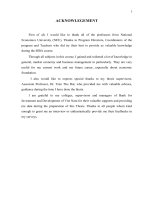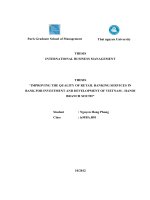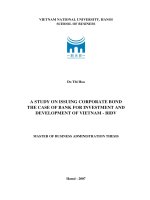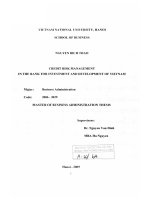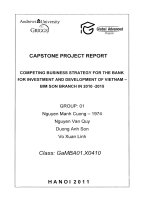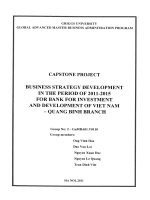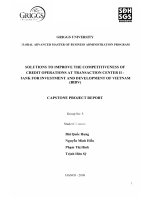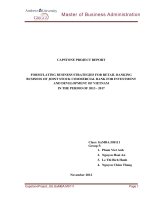enhancing the effectiveness of manpower administration activities in bank for investment and development of viet nam north hanoi branch
Bạn đang xem bản rút gọn của tài liệu. Xem và tải ngay bản đầy đủ của tài liệu tại đây (814.21 KB, 57 trang )
MINISTRY OF FINANCE
ACADEMY OF FINANCE
==============
Student: PHẠM DUY ĐẠI
Class: CQ47/51.03
ENHANCING THE EFFECTIVENESS OF MANPOWER
ADMINISTRATION ACTIVITIES IN BANK FOR INVESTMENT AND
DEVELOPMENT OF VIET NAM-NORTH HANOI BRANCH
GRADUATION PAPER
FACULTY OF FOREIGN LANGUAGES
Hanoi, May 2013
MINISTRY OF FINANCE
ACADEMY OF FINANCE
==============
Student: PHẠM DUY ĐẠI
Class: CQ47/51.03
ENHANCING THE EFFECTIVENESS OF MANPOWER
ADMINISTRATION ACTIVITIES IN BANK FOR INVESTMENT AND
DEVELOPMENT OF VIET NAM-NORTH HANOI BRANCH
GRADUATION PAPER
FACULTY OF FOREIGN LANGUAGES
Supervisor: M.A. Trần Thu Hoài
Hanoi, May 2012
ACKNOWLEDGEMENTS
I owe a debt of gratitude to those who has helped me complete this thesis.
First and foremost, I would like to express my thankfulness to Mrs. Trần Thu Hoài
MA, my supervisor, who gave me benefit of her wisdom and her expert knowledge
in grammar as well as encouraged me generously from working out the research
proposal to the writing up the thesis throughout this study.
I take this opportunity to express my sincere thanks to all my teachers in
Foreign Language Faculty at Academy of Finance for their useful lectures during
my bachelor course.
In addition, my appreciation is also extended to the 3rd year students of
Foreign Language Faculty at Academy of Finance for their kind support and warm
encouragement. I have received invaluable feedback from my participants, having a
great influence on the study.
Finally, my heartfelt thanks go to my family and my beloved friends for their
love, understanding, encouragement, and support throughout the course of my
study.
ABSTRACT
Human resource plays an important role in the success of every economy. In
Viet Nam, human resource is the vital element that helps the national economy
reaches the targets of industrialization and modernization. Therefore, the aim of
this study is to examine the human resources management activities and provide
some proper recommendations to managers of the enterprise.
During my internship in BIDV- North branch, I saw that the board of
managers of the branch has put their effort on improving the working performance
of employees. But there is still some weaknesses in the management process of
human resources from the recruitment process to employees’ policies. Thus, I have
studied about this situation and made some recommendations on this paper.
This paper is divided into three main sections. The first section discusses the
statement problem, the aim of the study, the scope of the study, the method of the
study and this overview. In the second section, background to the study, the study
will be clarified. Besides, there are some policies of the branch on human resources
management. In the third section, it gives a summary of advantages and
disadvantages of the branch on managing human resources and some
recommendation to improve it.
LIST OF ABBREVIATIONS
ATS
Applicants tracking system.
BIDV
Bank for Investment and Development of Viet Nam
HR
Human resources
HRP
Human resource planning
VND
Viet Nam dong.
LIST OF TABLES AND FIGURES
1. Figure 1: Organizational structure diagram of Northern Hanoi branch.
2. Figure 2: Sources of Recruitment.
3. Table 2.1: Table of capital mobilization of North Hanoi branch from 2005 to
2008.
4. Table 2.2: Table of business results of North Hanoi branch from 2005 to
2008.
5. Table 2.3: Table of capital using status of North Hanoi branch from 2005 to
2008.
6. Table 2.4: Table of labor structure by level at North Hanoi branch from 2007
to 2009.
7. Table 2.5: Table of labor structure by gender.
8. Table 2.6: Table of labor structure by age.
9. Table 2.7: Table of recruitment statistics.
TABLE OF CONTENTS
ACKNOWLEDGEMENT ....................................................................................... i
ABSTRACT ............................................................................................................. ii
ABBREVIATIONS ................................................................................................ iii
LIST OF TABLES, CHARTS, AND FIGURES.........................................iv
PART A: INTRODUCTION ............................................................................... 9
1. RATIONALE OF THE STUDY ................................................................. 9
2. AIMS OF THE STUDY ................................................................................ 9
3. METHOD OF THE STUDY ...................................................................... 10
4. SCOPE OF THE STUDY ........................................................................... 10
5. ORGANIZATION OF THE STUDY ....................................................... 11
6. SIGNIFICANCE ........................................................................................... 11
CHAPTER 1: LITERATURE REVIEW ....................................................... 12
1. General definition of manpower administration:.................................. 12
1.2. Roles of manpower administration: ......................................................... 13
1.3. Factors that influence the manpower administration activities ......... 14
1.3.1.The external factors:.................................................................................. 14
1.3.2.The internal factors: .................................................................................. 14
1.3.2.1Staffs: .......................................................................................................... 15
1.3.2.2Managers: .................................................................................................. 15
1.4. Manpower administration activities......................................................... 15
1.4.1.Planning the human resources: ............................................................... 15
1.4.2. Analyzing and designing specific activities: ......................................... 16
1.4.3.Recruitment:................................................................................................ 17
1.4.4.Training:....................................................................................................... 21
1.4.4.1. Training needs assessment:.................................................................. 21
1.4.4.2. Training design: ..................................................................................... 22
1.4.4.3. Training implementation: .................................................................... 22
CHAPTER 2: CURRENT SITUATION OF HUMAN RESOURCES
MANAGEMENT ACTIVITIES OF BIDV- NORTH HANOI BRANCH ....... 25
2.1. An overview of BIDV- North Hanoi branch: ......................................... 25
2.1.1. A brief overview of BIDV: ...................................................................... 25
2.1.2. An overview of BIDV- North Hanoi branch: ...................................... 26
2.1.2.1. History:..................................................................................................... 26
2.1.2.2. Organizational structure and main activities of the branch: ....... 26
2.2. Human resources characteristics:............................................................. 31
2.3. Human resources management policies: ................................................. 33
2.3.1. Recruitment policies: ................................................................................ 33
2.3.2. Training policies: ....................................................................................... 34
2.3.3. Welfare and incentive policies: .............................................................. 34
2.3.3.1. Salary and allowances: ......................................................................... 34
2.3.3.2. Bonus: ....................................................................................................... 35
2.3.3.3. Incentive and welfare: ........................................................................... 35
2.3. Assessment on human resources management activities in North Hanoi
branch: ................................................................................................................... 35
2.3.1. Planning human resources:..................................................................... 36
2.3.2. Recruitment activities: ............................................................................. 36
2.3.2.1. Effective recruitment: ........................................................................... 36
2.3.2.2. Recruitment sources: ............................................................................ 38
CHAPTER 3: RECOMMENDATIONS ON THE DEVELOPMENT OF
BIDV- NORTH HANOI BRANCH ................................................................. 42
3.1. Advantages and disadvantages of branch’s business process: ........... 42
3.1.1. Advantages: ................................................................................................ 42
3.1.2. Disadvantages: ........................................................................................... 43
3.2. Oriented Development of North Hanoi branch: .................................... 43
3.2.1. Development plan of capital raising sector: ........................................ 43
3.2.2. Development plan of credit sector: ........................................................ 44
3.2.3. Development plan of service sector: ...................................................... 44
3.2.4. Development plan of human resources management sector: .......... 45
3.3. Recommendation to improve human resources management activities:
45
3.3.1. Completing the recruitment process: ................................................... 45
3.3.2. Completing the training process:................Error! Bookmark not defined.
3.3.3. Motivation: ......................................................Error! Bookmark not defined.
3.3.3.1. Creating a friendly work environment: .Error! Bookmark not defined.
3.3.3.2. Rewards: .......................................................Error! Bookmark not defined.
3.3.3.3. Developing great relationships in the workplace:Error! Bookmark not
defined.
3.3.3.4. Modernizing banking technology:...........Error! Bookmark not defined.
CONCLUSION ..................................................................................................... 54
EFERENCES.................................................................................................v
PART A: INTRODUCTION
1. RATIONALE OF THE STUDY
From the dawn of humans’ history, we-people always play a very important role in
the production and business activities. We are the main elements that make up the
organization and determine the success or failure of the organization. Thus, the
manpower administration activities also become an indispensable part of any one
company.
Nowadays, as the competition in business is becoming more and more acute, every
organization needs to further improve its management of human resources. Since it
can promote the contribution of employees to the company and improve the labor
productivity. Being the top-rated bank of Viet Nam in many years, BIDV obviously
knows about this problem and have many significant activities like organizing
training courses monthly and annually, building more infrastructure for learning
and studying…
But there is the fact that the labor market of Viet Nam is being redundant. This
becomes a big question for the leaders of BIDV that how they can manage their
workforce effectively on both the quantity and the quality.
Carrying out my internship period in BIDV’s North Ha Noi branch, I have a change
to study the current situation of branch’s human resources management activities
and find the solution to improve or overcome shortcomings that are founded. I
chose the study “Enhancing the effectiveness of manpower administration activities
in Bank for Invesment and Development of Viet Nam- North Ha Noi branch” with
the aim of having an overview of branch manpower management activities, hence
be able to propose essential solutions to improve the quality of labor management
activities at BIDV’s North Ha Noi branch.
2. AIMS OF THE STUDY
The objectives of the Research are formulated as followed:
To gain a full view of manpower management situation of almost Viet Nam’s
business organizations.
To analyze the specific situation and shortcoming of human resources management
activities of BIDV Ha Noi.
To find out solutions to improve the human resources management activities.
To draw out some recommendation to get a better management method and
activities.
3. METHOD OF THE STUDY
In order to perform this Research, I first choose the method of analyzing,
summarizing and synthesizing materials and books to form the theoretical
background. Besides, I also use charts, tables and factual data for support. From the
collected information and data, I can assess and analyze the situation to draw
conclusion and find out feasible solutions to improve the human resources
management system of BIDV.
4. SCOPE OF THE STUDY
This paper is intended, as the title suggests: “Drawing an overview of manpower
management system, point out shortcomings and some short term as well as long
term improvement in North Ha Noi branch of BIDV”, to touch upon some
following issues:
The background and characteristics of using manpower in BIDV.
The current situation of using manpower in the branch and shortcomings.
The practical recommendations to improve the manpower management
system.
5. ORGANIZATION OF THE STUDY
The study is divided into three parts:
The first part is the introduction dealing with the rationale, aims, methods,
scope, organization and significance of the study.
The second part is the crucial part of the thesis with three chapter:
Chapter 1: Basic theory of manpower administration and management.
Chapter 2: Current situation of manpower administration activities in BIDV’s
North Ha Noi branch.
Chapter 3: Solution to improve the situation of the branch.
The last part is the conclusion that summarizes the content of the thesis, gives a list
of source of reference information and reference books.
6. SIGNIFICANCE
It is hoped that this study, to some extent, will be a useful reference material and
inspiration for managers and administrators to build strategic plan in the near
future.
CHAPTER 1: LITERATURE REVIEW
1. General definition of manpower administration:
According to vietdictionary.com, manpower is the perceived need, on the part of
a member of large organization, to improve their competitive positions both
nationally and internationally. Today, the manpower plays a vital role in the
organization’s strategic planning process. This trend is increasing pressure from the
global marketplace and from stockholders, both of which push for ever-higher
levels of productivity and profitability. This pressure is compounded by increased
recruitment and benefit costs, an aging workforce, an increasing number of health
and safety regulations, and an increasingly litigious society.
Manpower administration is defined in cfvg.com as that part of management
concerned with: all the decisions, strategies, factors, principles, operations,
practices, functions, activities and methods related to the management of people as
employees in any type of organization; all the dimensions related to people in their
employment relationships and all the dynamics that flow from it. Manpower
administration is the effective management of people at work. Manpower
administration examines what can or should be done to make working people more
productive and satisfied. It is specifically charged with programs along with people,
the employees. Manpower administration is the function performed in
organizational and individual goals. Whether a manpower administration function
or department exists in a firm, every manager must be concerned with people.
Therefore it is a necessary function. Effectively performed, it can make the
difference between successful and unsuccessful organizations. Manpower
administration activities are now tied to the bottom line, where it is considered a
“profit center” rather than a “cost center.”
1.2.
Roles of manpower administration:
The manpower administration function was merely an inappreciable unit in many
organizations until upper management recognized the critical role that people play
in meeting organizational objectives. Today, the importance of recruiting, selecting,
training, developing, rewarding, compensating, and motivating is recognized by
managers in every unit and functional area of an organization. Effective manpower
administration adds value to the delivery of goods and services and to the quality of
work life for employees, by helping to ensure continuous organizational success in
transformative environments.
Effective manpower administration helps stimulate the development of manpower.
The development of manpower refers to the development acquisition of knowledge,
skills and behaviors that improve employees’ ability to meet changes in job
requirements and internal or external customer demands. The manpower
development combines administration with the management of resources.
Integration is one of the key features of manpower administration. The first role
played by manpower administration is being a support system. It can provide
guidance and supervision for people management in the workplace. The second
role is that of human resource. This means that it will include necessary tasks such
as training, development, recruitment, motivation, evaluation and planning. The
next role is strategic management, playing an important part within the corporate
strategy. Strategic manpower management is a key part of the decision making
cycle.
The role of human resource development within the new business environment as
follow: The first is to integrate the aspects of the new business environment with
the existing policies and strategies of the organization. The second is human
resource management must nurture and develop a company intellectual capital and
recruitment, retain, develop and manage the human assets for the company to have
competitive advantages.
1.3.
Factors that influence the manpower administration activities
There are many factors that influence the manpower administration activities, both
positively and negatively. Apart from that, each manager knows that while building
the human resources management policy, these factors are indispensable. In theory,
there are the internal and external factors.
1.3.1. The external factors:
The first factor is the context of the economy. Every manpower activity of every
enterprise is influenced by the context of the economy. When the economic is
unstable, the managers not only have to remain the quality of the manpower
qualified and well-trained but also reduce the labor costs by cut off the working
hours, salary and rewards. In contrast, when the economy grows up, it’s time for
developing the human resource activities. In conclusion, the contexts of the present
economy influence directly the manpower administration and the enterprise must
have the appropriate human resource policies.
The second factor is the population. Viet Nam is a young and populous country
with a large labor market. If the labor quality is high, the enterprises can save their
training expenses and enhance the effectiveness of their manpower administration
activities. But when the human resource is not enough, it will make the recruitment
process becomes more difficult and lower the effectiveness of the human resource
management activities.
The next factor is technology. The development of technology has a strong impact
on the management of manpower. When technology changes, it requires less labors
but more effective. Therefore, enterprises should adjust their human resources
management policy to fit the new requirement.
The last factor is the opponents. There always have opponents in business. In this
competitive environment, enterprises themselves must continuously enhance and
complete their human resource policy likes a satisfactory salary level, righteous
reward and motivation.
1.3.2. The internal factors:
1.3.2.1. Staffs:
Every staff has their own ability, characteristics, interests and aspirations. So the
managers should build the manpower administration policy for each type of staff.
1.3.2.2. Managers:
The manager themselves is an important factor. They declare the policy and the
orientation for the enterprise. Thus, reality shows that if the managers are
professional and visionary, their policies are definitely better.
1.4.
Manpower administration activities
1.4.1. Planning the human resources:
We can understand that planning the human resources is the ongoing process of
systematic planning to achieve the maximum use of human resources. The
objective of HRP is to ensure the best fit between employees and jobs, while
avoiding manpower shortages or surpluses. There are three elements of the HRP
process including forecasting labor demand, analyzing present labor supply and
balancing projected labor demand and supply.
Stage 1: Forecasting labor demand
There are several ways to forecast your business needs, in order to predict how
many employees you need to run your business and which roles these employees
need to fill. Some of the factors to consider include the situation of the economy,
the internal business finances, the demand for your products or services, and the
growth expectations for your business. Enterprises should consider their existing
staff and see which current employees are likely to transition into new positions
and estimate the turnover rate of employees for your business.
Stage 2: Analyzing present labor supply
Evaluating the supply of employees consists of a two-prong process: evaluating
internal staff (which will occur as you are forecasting your staffing needs) as well
as external staff. Externally, you need to evaluate the demographics of the
workforce that is available. This include factors such as education, mobility, the
unemployment rate, state and federal government laws, regulations that can affect
your industry, your business, existing and potential employees. Evaluating all of
these factors helps you determine if you have access to the number and types of
employees you need to fill your staffing forecasts.
Stage 3: Balancing projected labor demand and supply
The final element of the human resources planning model is to determine how you
are going to balance the demand you have for employees with the supply of
employees available. If you have a shortage of employees, this will determine what
type of recruiting efforts your business will participate in to attract the employees it
needs to fill needs within the company. You are also required to balance you fulltime and part-time needs. If you have a surplus of employees, this requires you to
consider employee layoffs, retirements and situations where employees may need
to be demoted or moved into a lateral position (rather than receiving a promotion).
1.4.2. Analyzing and designing specific activities:
To produce their given product or service, companies require a number of tasks to
be performed. The tasks are grouped in various combinations to form jobs. Ideally,
the tasks should be grouped in ways that help the organization to operate efficiently
and obtain people with the right qualification to do the jobs well. This function
involves the activities of job analysis and job design. Job analysis is the process of
getting detailed information about jobs. Job design is the process of defining the
way work will be performed and the tasks that a given job requires.
So, the importance of job analysis and job design in a company varies in five ideas.
The first is analyzing the resources and establishing the strategies to accomplish the
business goals and strategic objectives. The second is effectively developed;
employee job descriptions are communication tools that are significant in an
organization’s success. The next idea is being used in training to identify or
develop, training content, and assessment tests to measure effectiveness of training,
equipment to be used in delivering the training and methods of training. Last but
not least, job analysis and job design can be used in performance review to identify
or develop goals and objectives, performance standards, evaluation criteria, length
of probationary periods, and duties to be evaluated. The last is being used in
selection procedures to identify or develop job duties that should be included in
advertisements of vacant positions.
As usual, job analysis and design contain three elements: Planning the job analysis,
gathering information and using that information.
1.4.3. Recruitment:
Recruitment is the process whereby a firm attracts or finds capable individuals
to apply for employment. Of course, the objective is to find these applicants at
the lowest possible cost.
This process begins when new recruits are sought, and ends when applicants
have submitted application forms or resumes. The result is a pool of job-seekers
from which the firm can then the select the most qualified.
Smart companies recruit employees they can retain, and retention depends on
getting the right people in the right job in the first place. So, while getting a
large pool applicants is important, getting the right type of applicant is even
more important.
In order to increase efficiency in hiring and retention and to ensure consistency
and compliance in the recruitment and selection process, it is recommended the
following steps:
Step 1: Identify vacancy and evaluate need
Recruitments provide opportunities to departments such as aligning staff skill sets
to initiatives and goals and planning for departmental and individual growth.
Although there is work involved in the hiring process, proper planning and
evaluating of the need will lead to hiring the right person for the role and team.
Step 2: Develop position description
A position description is also referred to as a job description is the core of a
successful recruitment process. From the job description, interview questions,
interview evaluations and reference checks questions are developed.
Prior to developing the job description, the hiring manager should identify the
following: General information, position purpose, essential function, minimum
requirements, and preferred qualifications.
Step 3: Develop recruitment plan
Each position requires a documented Recruitment Plan which is approved by the
organizational unit. A carefully structured recruitment plan maps out the strategy
for attracting and hiring the best qualified candidate and helps to ensure an
applicant pool which includes women and underrepresented groups including
veterans and individuals with disabilities.
In addition to the position’s placement goals, the plan contains advertising channels
to be used to achieve those goals. The recruitment plan is typically developed by
the hiring manager in conjunction with the Departmental HR Coordinator.
To ensure the most current placement goals which are identified for the department
and unit, you may contact the office of Faculty and Staff Affirmative Action.
Recruitment Plan Elements are: posting period, placement goals, additional
advertising resources, diversity agencies, and resume banks.
Step 4: Select search committee
To ensure applicants selected for interview and final consideration are evaluated by
more than one individual to minimize the potential for personal bias, a selection
committee is formed. The hiring manager will identify members who will have
direct and indirect interaction with the applicant in the course of their job. Each
hiring manager should make an effort to appoint a search committee that represents
a diverse cross section of the staff.
Step 5: Post position and implement recruit plan
Once the position description has been completed, the position can then be posted
to the UCR career site via the ATS. Every effort should be made to ensure the
accuracy of the job description and posting text. It is not advisable and in some
instances, not possible to change elements of a posted position. The reason for this
has to do with the impact a given change may have on the applicant pool.
To post the position:
The requisition is created by the Service Center Human Resources Coordinator or
Departmental Human Resources Coordinator and approved by the Service Center
HR Organizational Coordinator or Organizational HR Coordinator. Once approved,
the Departmental HR Coordinator or Service Center will review the requisition and
route online to the HR Classification Analyst who will assign the classification.
The requisition is then routed to the HR Recruitment Analyst who will post the
position. Applications can be reviewed once the minimum number of posting days
has been reached. Internal candidates will apply through the regular application
process and will be included in the candidate pool along with external candidates.
Step 6: Review applicants and develop short list
All applicants must be reviewed and considered. Applicants are those who apply
during the initial application period as described in Step 5. Candidates who apply
after the initial application period will be considered “expressions of interest” and
not viewable by the search committee.
It is recommended that all search committee members review all Applicants to
ensure more than one person assesses their qualifications and that individual
opinion or biases are avoided. Each committee member may give comments to
each Applicant’s qualifications as they relate to the minimum requirements of the
position.
Upon the search committee’s review of each Applicant, the Chair or Chair’s
Associate will review all search committee comments and develop the short list.
Once the short list has been determined, the AACO will request an Affirmative
Action Applicant Pool Statistics analysis from the OFSAA. If the short list is
deemed to represent a sufficiently diverse applicant pool, the short list will be
approved. Once approved, the applicants can then be contacted for interviews.
Step 7: Conduct interview
The interview is the single most important step in the selection process. It is the
opportunity for the employer and prospective employee to learn more about each
other and validate information provided by both. By following these interviewing
guidelines, you will ensure you have conducted a thorough interview process and
have all necessary data to properly evaluate skills and abilities.
Step 8: Select hire
Final Applicant:
Once the interviews have been completed, the committee will meet to discuss the
interviewees. Committee members will need to assess the extent to which each one
met their selection criteria.
The search committee rating sheet will be helpful in justifying decisions and
making them as objective as possible.
As one of the most critical steps in the process, it is important to keep the
following in mind:The best candidate for the position was chosen based on
qualifications and the candidate will help to carry out the University and
Department’s missions.
Reference Checks:
Reference checks should be conducted on the final applicant prior to making an
offer. While it is advisable to conduct a reference with the candidate’s current
supervisor before a candidate starts employment, if the candidate is reluctant a
conditional offer of employment can be made.
Step 9: Finalize recruitment
Upon completion of the recruitment process the offer to the selected finalist is
made. The salary to be offered is to be equitable and lead to the retention and
motivation of employees.
Prior to initiating the offer, it is recommended that one more check of the selection
process be completed as follows: first is to review the duties and responsibilities of
the position. Second is to review selection criteria used to ensure they were based
on the qualifications listed for the position. Next is confirming interview questions
clearly matched the selection criteria. And last is confirming all applicants were
treated uniformly in the recruitment, screening, interviewing and final selection
process
1.4.4. Training:
The process of HR training and development consists of the following steps:
Training needs assessment
Training design
Training implementation
Training evaluation
1.4.4.1. Training needs assessment:
Training needs assessment analyzes the organization’ needs; the knowledge, skill,
and ability needed to perform the job; and the person’ needs. The organization
needs assessment requires an examination of the long or short term objectives of
the firm. Training needs assessment shall be conducted for all staff as a part of the
annual performance development review. New staff may need to have their training
needs assessed more regularly. Wherever possible, staff will be offered training
relevant to their positions. Training is an opportunity not a right and therefore it is
not possible to offer staff training in skills which are not directly linked to these
positions.
1.4.4.2. Training design:
Training design is a process that requires a blend of instructional learning
principles and media selection. After assessing training needs, it is necessary to
design courses for training such as setting up training objectives, methods,
materials and contents. All training facilities are essential for any training course
and need to be prepared carefully. Human resource department cannot carry out
this step. It can save cost for the organization but does not meet staff expectation on
training effectiveness.
1.4.4.3. Training implementation:
Location, time and other logistic arrangement for training are informed to staff
timely. The teachers prepare not only training contents/ materials but also other
related knowledge/ suitable methods/ skills. The subjects of training also are
identified suitable for the content of training. Training conduction is carried out
right after every preparation steps are ready.
Job evaluation:
A job evaluation is a systematic way of determining the value/worth of a job in
relation to other jobs in an organization. It tries to make a systematic comparison
between jobs to assess their relative worth for the purpose of establishing a rational
pay structure.
The process of job evaluation involves the following steps:
Gaining acceptance: Before undertaking job evaluation, top management must
explain the aims) and uses of the programme to the employees and unions. To
elaborate the programme further, oral presentations could be made. Letters,
booklets could be used to classify all relevant aspects of the job evaluation
programme.
Creating job evaluation committee: It is not possible for a single person to evaluate
all the key jobs in an organisation. Usually a job evaluation committee consisting
of experienced employees, union representatives and HR experts is created to set
the ball rolling.
Finding the jobs to be evaluated: Every job need not be evaluated. This may be too
taxing and costly. Certain key jobs in each department may be identified. While
picking up the jobs, care must be taken to ensure that they represent the type of
work performed in that department.
Analysing and preparing job description: This requires the preparation of a job
description and also an analysis of job needs for successful performance .
Selecting the method of evaluation: The most important method of evaluating the
jobs must be identified now, keeping the job factors as well as organisational
demands in mind.
Classifying jobs: The relative worth of various jobs in an organisation may be
found out after arranging jobs in order of importance using criteria such as skill
requirements, experience needed, under which conditions job is performed, type of
responsibilities to be shouldered, degree of supervision needed, the amount
of stress caused by the job, etc. Weights can be assigned to each such factor.
Treatment:
Treatment stimulates staffs to perform better, harder and more satisfied. There are
two kinds of treatment:
Physical treatment:
Salary: From a business point of view, salary can be deemed as the cost of
acquiring human resources for running operations and is then termed personnel
expense or salary expense.
Bonus payment: A bonus payment is usually made to employees in addition to their
base salary as part of their wages.
Mental treatment:
Arrange appropriate position for each staff.
Take care of staffs’ families.
Remove distance between superior and inferior.
CHAPTER 2: CURRENT SITUATION OF HUMAN RESOURCES
MANAGEMENT ACTIVITIES OF BIDV- NORTH HANOI BRANCH
2.1. An overview of BIDV- North Hanoi branch:
2.1.1. A brief overview of BIDV:
BIDV is the oldest Commercial Bankin Vietnam. History of construction and
development of BIDV is a difficult and trial but very proud path associating with
historic period against invaders and country construction of Vietnam people.
Founded on 26th April 1957 under the name Bank for Construction of Vietnam
From 1981 to 1989: Under the name Bank for Investment and Construction of
Vietnam
From 1990 to 27/04/2012: Under the name Bank for Investment and
Development of Vietnam (BIDV)
From 27/04/2012 to now: Under the name Joint Stock Commercial Bank for
Investment and Development of Vietnam (BIDV)
Along with country development, Joint Stock Commercial Bank for Investment and
Development of Vietnam contributed to postwar economic rehabilitation and
implementation of the first five-year plan (1957-1965). Vietnam must carry out two
strategic duties for building socialism. They are to be against sabotage of America
toward the North and to reinforce the South for national unity (1965-1975),
